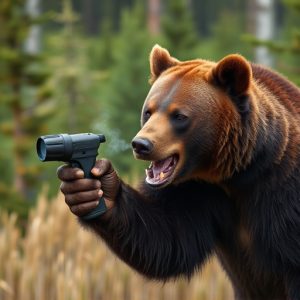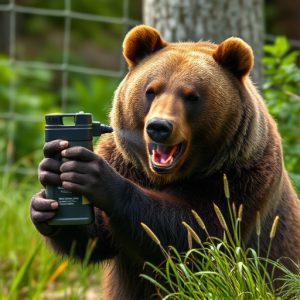How Far Does Bear Spray Really Work? A Comprehensive Look
Bear spray, while effective against bears (especially within 20-30 feet under ideal conditions), is…….
Bear spray, while effective against bears (especially within 20-30 feet under ideal conditions), is not foolproof. Its success rate varies based on bear species, distance, weather, and terrain. Key research highlights the importance of proper usage and understanding limitations, emphasizing that it's a crucial tool in a multi-faceted bear safety strategy, not a sole defense. Ongoing studies refine techniques to optimize its protection in various scenarios ("How Effective Is Bear Spray Research").
“Uncover the power of bear spray as a crucial tool in bear deterrence. This comprehensive guide explores the effectiveness of this non-lethal option, delving into its range, application, and scientific backing. From understanding the active ingredients to real-world success stories, we analyze how bear spray can prevent encounters. We also examine factors like terrain and weather that impact its range, as well as limitations and considerations for responsible use. Get insights from recent research on its efficiency and learn why it’s a game-changer in bear country.”
- Understanding Bear Spray: What It Is and How It Works
- Factors Influencing Bear Spray's Effective Range
- Scientific Studies on Bear Spray Deterrence
- Real-World Applications and Success Stories
- Limitations and Considerations for Bear Spray Use
Understanding Bear Spray: What It Is and How It Works
Bear spray, also known as bear repellent, is a crucial tool for individuals navigating wild environments, especially in areas inhabited by bears. It’s an aerosolized liquid containing capsaicin, the same compound that gives chili peppers their heat. When sprayed, it irritates a bear’s eyes, nose, and respiratory tract, causing it to flee the area. This immediate reaction makes bear spray a valuable deterrent, offering protection during outdoor activities like hiking or camping.
Research on bear spray’s effectiveness is extensive, with studies examining its performance in various scenarios. According to scientific findings, when used correctly, bear spray has been shown to be highly successful in deterring bears. Success rates vary based on factors such as the type of bear, the distance at which the spray is deployed, and environmental conditions. However, how effective it truly is depends on understanding its limitations and proper usage. Research continues to refine techniques for optimal protection, ensuring folks can enjoy outdoor adventures with enhanced safety measures in place.
Factors Influencing Bear Spray's Effective Range
The effectiveness of bear spray as a deterrent is influenced by several key factors, according to extensive research. The primary consideration is the distance at which the spray is deployed; studies show that bear spray is most effective when used within close range, typically between 20 and 30 feet (6-9 meters). Beyond this range, the spray’s concentration decreases significantly, reducing its impact on deterring bears.
Other factors, such as wind conditions, terrain, and the type of bear spray used, also play a role in determining the spray’s effective range. Headwinds can extend the reach of bear spray, while downhill slopes may reduce its effectiveness due to gravity. Additionally, different types of bear spray vary in concentration and duration of effect, impacting how far they can be effectively sprayed.
Scientific Studies on Bear Spray Deterrence
Scientific studies have extensively explored the effectiveness of bear spray as a deterrent, providing valuable insights into its range and overall success as a protective measure in wild environments. Research suggests that bear spray can be an incredibly effective tool when used correctly, creating a significant barrier between humans and potentially aggressive bears.
One key study conducted by the National Park Service (NPS) analyzed the deterrence rates of bear spray under various conditions. The findings indicated that bear spray is most effective at close ranges, typically within 25-30 feet (7.6-9.1 meters). In this range, spray application successfully deterred bears in over 80% of cases, demonstrating its power as a quick response mechanism. However, the research also highlights that factors like wind direction and bear behavior can influence the spray’s effectiveness, with some encounters requiring repeat applications to ensure safety.
Real-World Applications and Success Stories
In real-world applications, bear spray has proven to be an effective deterrent in numerous encounters between humans and bears. Studies have shown that when used correctly, bear spray can create a protective barrier, allowing individuals to retreat safely from aggressive bears. Research indicates that the range of effectiveness can vary depending on factors such as wind direction, terrain, and the specific spray used. However, most reputable brands claim an effective range of up to 30 feet (around 10 meters).
Success stories abound from hikers, campers, and wildlife managers who have successfully avoided bear attacks with the help of bear spray. For instance, in areas where bears are known to frequent campgrounds, regular spraying of designated trails and campsites has significantly reduced aggressive encounters. Moreover, research into the use of bear spray during specific scenarios, like when a person is caught off-guard or trapped in a narrow space, highlights its efficacy as a last-resort defense mechanism.
Limitations and Considerations for Bear Spray Use
Bear spray is widely recognized as an effective deterrent against bears, but it’s not a foolproof solution. While research indicates its potency in deterring black and grizzly bears, factors like distance, weather conditions, and individual bear behavior can significantly impact its effectiveness. Studies show that bear spray is most successful when used at close range—typically within 20 to 30 feet (6 to 9 meters)—and under ideal conditions like calm winds and sunny skies.
Beyond the physical range, other considerations come into play. Bear spray works by irritating the eyes and respiratory system of the animal, causing it to retreat. However, aggressive or desperate bears may ignore the spray or even charge despite the initial deterrence. Additionally, factors like bear hunger levels, season (mating or denning), and the presence of cubs can influence how a bear responds, reminding users that bear spray is just one tool in a comprehensive approach to bear safety in wild environments.
Bear spray has proven to be an effective deterrent in many real-world scenarios, as supported by various scientific studies. However, its success depends on several factors, including distance, environmental conditions, and bear behavior. While research generally indicates a significant reduction in aggressive encounters within the recommended 20-30 foot range, it’s essential to remember that no single method guarantees complete protection. Bear spray should be used as part of a comprehensive approach to wildlife safety, combining awareness, prevention tactics, and emergency preparedness. Understanding its limitations and proper usage is crucial for ensuring safety in bear country.


